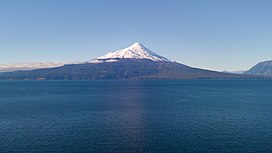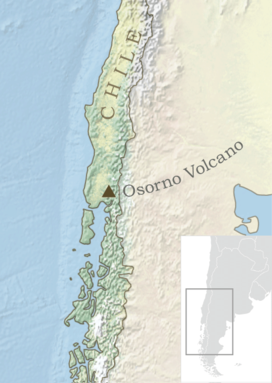Osorno (volcano)
This article needs additional citations for verification. (February 2010) |
| Osorno | |
|---|---|
 Osorno Volcano and Llanquihue Lake | |
| Highest point | |
| Elevation | 2,652 m (8,701 ft)[1] |
| Coordinates | 41°06′00″S 72°29′35″W / 41.10000°S 72.49306°W[1] |
| Geography | |
| Location | Chile |
| Parent range | Andes |
| Geology | |
| Mountain type | Stratovolcano |
| Volcanic arc/belt | South Volcanic Zone |
| Last eruption | 1869[1] |
| Climbing | |
| First ascent | 1848 by Jean Renous |
| Easiest route | rock/snow/ice climb |
Osorno Volcano is a 2,652-metre (8,701 ft) tall conical stratovolcano lying between Osorno Province and Llanquihue Province, in Los Lagos Region of Chile. It stands on the southeastern shore of Llanquihue Lake, and also towers over Todos los Santos Lake. Osorno is considered a symbol of the local landscape and as such, tends to be the referential element of the area in regards to tourism.
Osorno is one of the most active volcanoes of the southern Chilean Andes, with 11 historical eruptions recorded between 1575 and 1869, including an eruption on January 19, 1835, which was witnessed by British Naturalist, Charles Darwin.[2] The basalt and andesite lava flows generated during these eruptions reached both Llanquihue and Todos los Santos Lakes. The upper slopes of the volcano are almost entirely covered in glaciers despite its very modest altitude and latitude, sustained by the substantial snowfall in the very moist maritime climate of the region. This mountain also produces pyroclastic flow, since it is a composite volcano.
Osorno sits on top of a 250,000-year-old eroded stratovolcano, La Picada, with a 6-km-wide caldera.[3]
Trivia
- Charles Darwin glimpsed Volcán Osorno from a distance in the course of the second voyage of the Beagle, catching sight of its eruption in January 1835.[4][5]
- The volcano looks similar in appearance to Mt Fuji in Japan.[6][7]
Image gallery
|
See also
References
- ^ a b c "Osorno". Global Volcanism Program. Smithsonian Institution. Retrieved 2010-05-06.
- ^ "Darwin's earthquakes". Darwin Correspondence Project. 2016-01-18. Retrieved 2022-03-04.
- ^ "Volcanoes of South America". Global Volcanism Program. Smithsonian Institution. Retrieved 2010-02-23.
- ^ "Sierra magazine, Jan/Feb 2006, travel column, "Good Going"". Archived from the original on 2017-07-05. Retrieved 2006-02-02.
- ^ "The American Museum of Natural History: A Trip Around the World". Archived from the original on 2006-01-28. Retrieved 2006-02-02.
- ^ "Osorno Volcano, Chile". www.patagonia-calling.com. Retrieved 2022-03-01.
- ^ "Osorno Volcano |". Alluring World. 2017-08-16. Retrieved 2022-03-01.
- Biggar, John (2005). The Andes: A Guide for Climbers (3rd ed.). Andes Publishing (Scotland). p. 304 pp. ISBN 0-9536087-2-7.
- González-Ferrán, Oscar (1995). Volcanes de Chile. Santiago, Chile: Instituto Geográfico Militar. p. 640 pp. ISBN 956-202-054-1. (in Spanish; also includes volcanoes of Argentina, Bolivia, and Peru)
- Articles with short description
- Articles needing additional references from February 2010
- All articles needing additional references
- AC with 0 elements
- Stratovolcanoes of Chile
- Mountains of Chile
- Active volcanoes
- Volcanoes of Los Lagos Region
- Mountains of Los Lagos Region
- South Volcanic Zone
- Holocene stratovolcanoes








